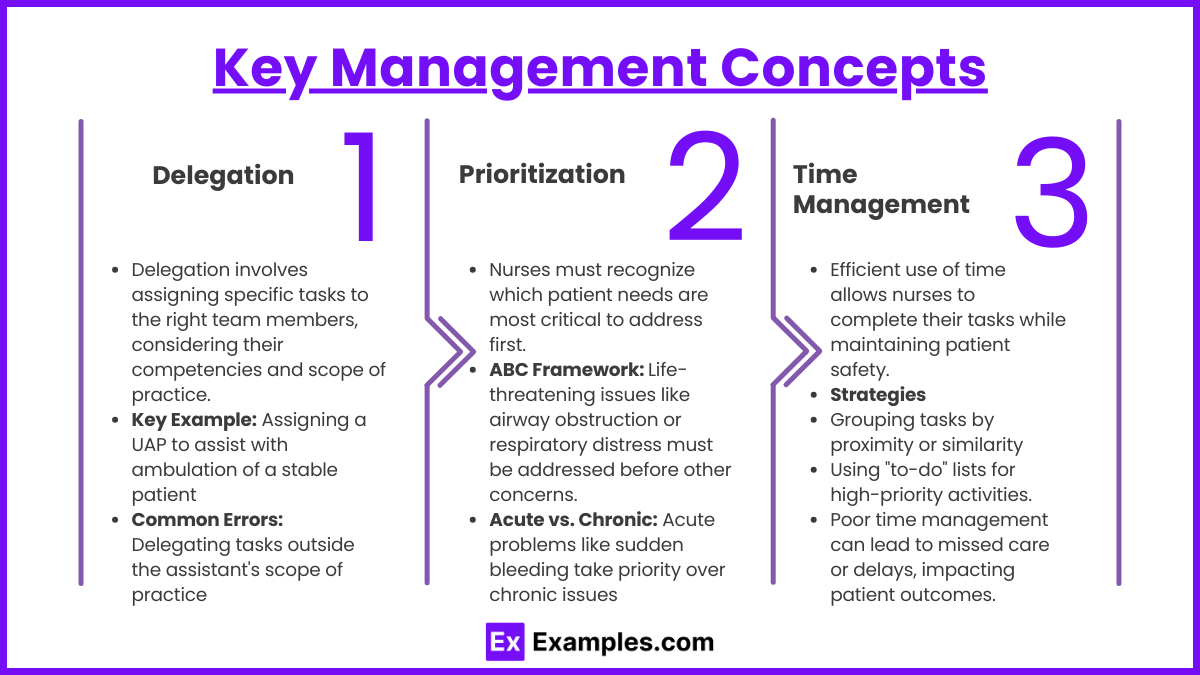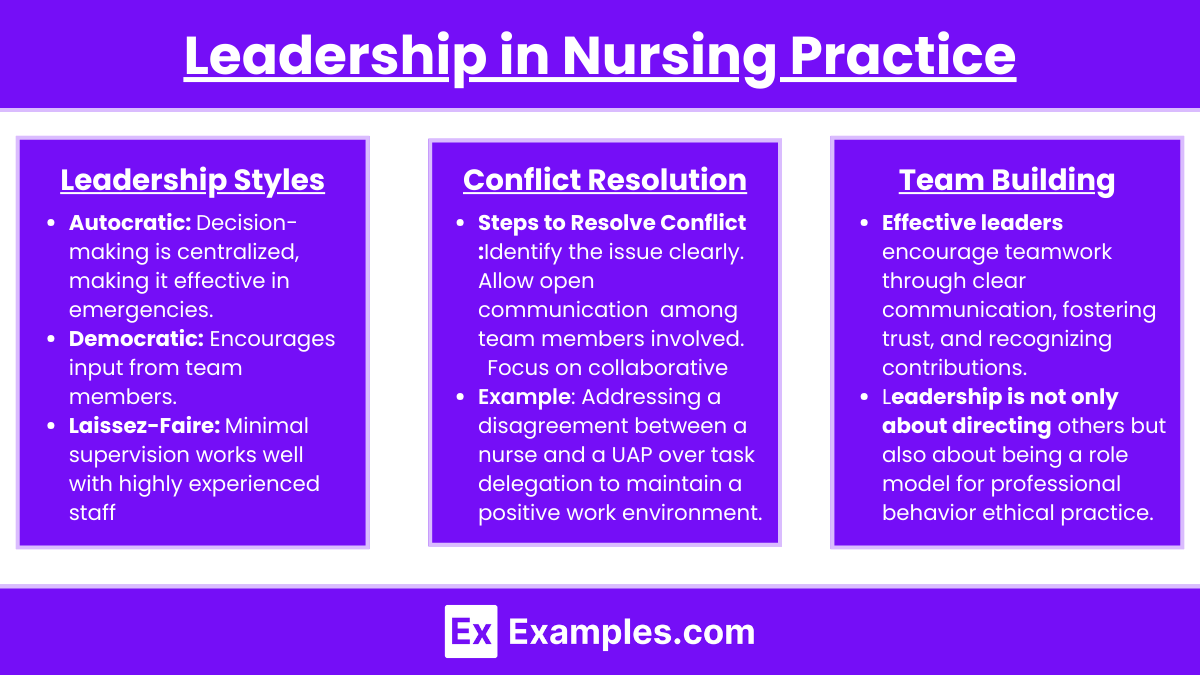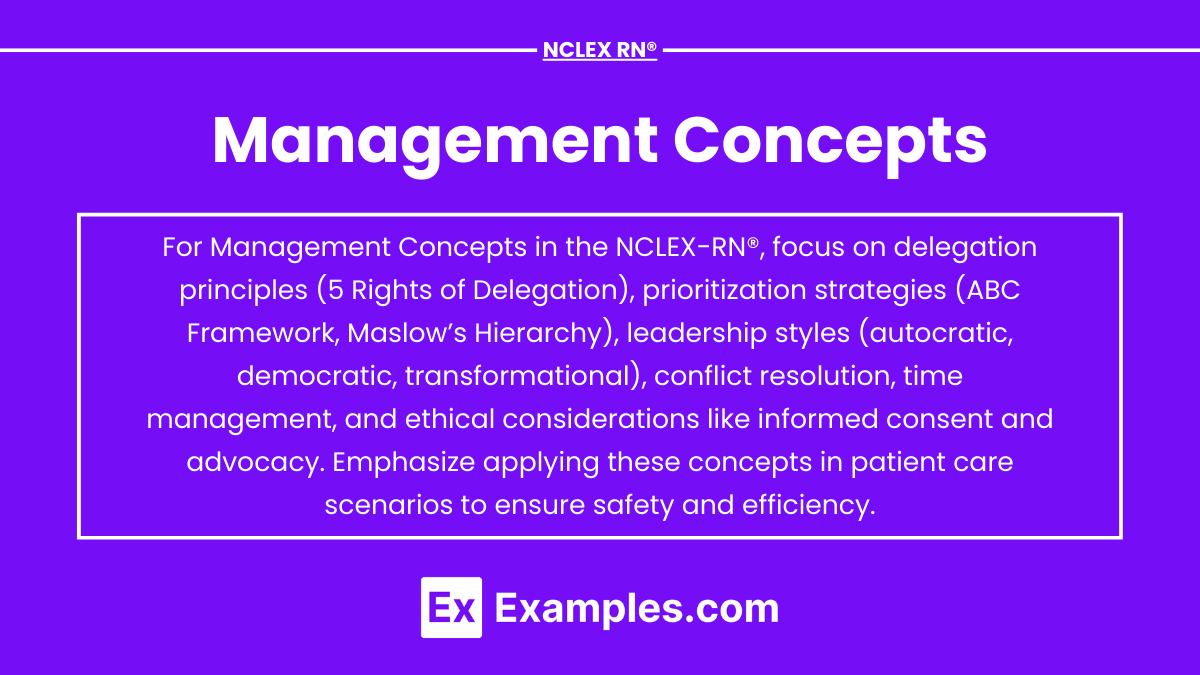Management concepts are integral to the NCLEX-RN®, focusing on the nurse's ability to lead, prioritize, delegate, and coordinate care effectively. These concepts ensure safe, efficient, and high-quality patient outcomes by emphasizing critical thinking, ethical practice, and teamwork. Understanding frameworks like the "5 Rights of Delegation," prioritization techniques, and leadership styles is essential for navigating complex patient scenarios. Mastery of these principles not only prepares you for exam success but also equips you to handle real-world challenges in a professional healthcare setting.
Learning Objectives
In studying "Leadership & Management: Management Concepts" for the NCLEX-RN® Exam, you should learn to understand essential principles such as delegation, prioritization, and time management. Analyze frameworks like the "5 Rights of Delegation," ABC prioritization, and Maslow’s Hierarchy of Needs. Evaluate the impact of leadership styles, including autocratic, democratic, and transformational approaches, on team dynamics and patient outcomes. Additionally, explore conflict resolution strategies and ethical considerations in nursing practice. Apply this knowledge to interpreting scenarios involving patient safety, resource allocation, and team collaboration, ensuring effective decision-making and promoting optimal outcomes in NCLEX-style practice questions.
1. Key Management Concepts

Management concepts provide the foundation for ensuring patient safety, efficiency, and high-quality care in nursing practice. Understanding and applying these principles are critical for success in the NCLEX-RN® and real-world scenarios.
1.Delegation
Delegation involves assigning specific tasks to the right team members, considering their competencies and scope of practice.
Key Example: Assigning a UAP to assist with ambulation of a stable patient while the nurse focuses on assessing a patient with sudden chest pain.
Nurses retain accountability for the outcome of the delegated task, even when others perform it.
Common Errors: Delegating tasks outside the assistant's scope of practice or providing unclear instructions.
2.Prioritization
Nurses must recognize which patient needs are most critical to address first.
ABC Framework: Life-threatening issues like airway obstruction or respiratory distress must be addressed before other concerns.
Acute vs. Chronic: Acute problems like sudden bleeding take priority over chronic issues like diabetes management.
Key Example: Prioritizing a post-operative patient with a drop in blood pressure over a patient requesting medication for mild pain.
3.Time Management
Efficient use of time allows nurses to complete their tasks while maintaining patient safety.
Strategies include:
Grouping tasks by proximity or similarity (e.g., giving medications and checking vital signs for patients in the same area).
Using "to-do" lists for high-priority activities.
Poor time management can lead to missed care or delays, impacting patient outcomes.
2. Leadership in Nursing Practice

Leadership plays a vital role in fostering teamwork, maintaining safety standards, and ensuring positive patient outcomes. Nurses must understand various leadership styles and their applications.
Leadership Styles
Autocratic: Decision-making is centralized, making it effective in emergencies. For example, a charge nurse directing staff during a code blue situation.
Democratic: Encourages input from team members. Useful during team meetings for collaborative decision-making.
Laissez-Faire: Minimal supervision works well with highly experienced staff who are self-motivated.
Transformational: Focuses on motivating and inspiring the team to achieve shared goals, such as implementing a new patient care protocol.
Conflict Resolution
Steps to Resolve Conflict:
Identify the issue clearly.
Allow open communication among team members involved.
Focus on a collaborative resolution.
Evaluate and monitor the outcome.
Example: Addressing a disagreement between a nurse and a UAP over task delegation to maintain a positive work environment.
Team Building
Effective leaders encourage teamwork through clear communication, fostering trust, and recognizing contributions.
Leadership is not only about directing others but also about being a role model for professional behavior and ethical practice.
3. Applications of Management Concepts

Management concepts are integral to the role of a nurse, both in daily practice and in scenarios presented during the NCLEX-RN® exam. These concepts help ensure safe, efficient, and high-quality patient care while demonstrating the nurse's ability to lead, prioritize, and manage resources effectively
1. Delegation in Clinical Practice
Delegation is the process of assigning tasks to appropriate team members while maintaining accountability for the outcomes. Nurses must follow the "5 Rights of Delegation" to ensure effective task completion.
Example: In a busy hospital setting, a nurse delegates the task of monitoring a patient’s blood glucose levels to a trained UAP. The nurse then focuses on assessing a critically ill patient. This ensures all patient needs are met without compromising care quality.
NCLEX Scenario: A question may ask which task a nurse can delegate to a UAP. For instance, assisting a patient with ambulation is appropriate, but administering medication is not within the UAP's scope of practice.
2. Prioritization for Safe Patient Outcomes
Prioritization involves determining the order in which tasks should be performed based on patient needs. Nurses use frameworks like ABC (Airway, Breathing, Circulation) or Maslow's Hierarchy of Needs to make these decisions.
Example: A nurse prioritizes treating a patient with acute respiratory distress over another requesting assistance with mobility.
NCLEX Scenario: A question may present multiple patients with different conditions and ask which patient the nurse should see first. Correct application of prioritization frameworks is key to answering these questions.
3. Time Management to Maximize Efficiency
Time management is crucial for ensuring all patient care activities are completed efficiently within a shift. Nurses must identify high-priority tasks, cluster similar tasks, and delegate when appropriate.
Example: A nurse organizes the morning by administering medications, completing assessments, and grouping tasks like vital sign checks for patients in adjacent rooms.
NCLEX Scenario: A question might ask which task the nurse should complete first during a busy shift. Tasks that address immediate patient needs, such as administering life-saving medications, take precedence.
4. Leadership in Team Collaboration
Effective leadership fosters a positive work environment, enhances team performance, and ensures patient safety. Nurses must adapt their leadership style to the situation, whether it requires quick decision-making or team input.
Example: In an emergency, a charge nurse adopts an autocratic leadership style to direct team actions efficiently, ensuring rapid response.
NCLEX Scenario: A question might describe a conflict between team members and ask how the nurse should resolve it. The correct approach involves facilitating open communication and fostering a collaborative resolution.
5. Ethical and Legal Responsibilities
Nurses must integrate ethical and legal principles into their management practices to protect patients and healthcare team members.
Example: Ensuring informed consent before a procedure and advocating for a patient who refuses treatment.
NCLEX Scenario: A question might present a situation where a patient’s autonomy is at risk, asking how the nurse should advocate for the patient while adhering to legal requirements.
Examples
Example 1: Delegation in a High-Pressure Situation
During a busy shift, a nurse is caring for multiple patients with varying needs. One patient requires assistance with toileting, another needs their blood glucose checked, and a third is complaining of sudden chest pain. The nurse delegates the toileting task to a UAP and the blood glucose monitoring to a licensed practical nurse (LPN), while personally attending to the patient with chest pain. This scenario demonstrates the application of delegation and prioritization to ensure all tasks are completed efficiently and life-threatening issues are addressed promptly.
Example 2: Prioritization Using the ABC Framework
A nurse is caring for four patients:
Patient A: Post-operative, stable, requesting pain medication.
Patient B: Diagnosed with pneumonia, experiencing shortness of breath.
Patient C: Awaiting discharge instructions and family arrival.
Patient D: Receiving IV fluids, with no immediate complaints.
The nurse assesses Patient B first, as breathing issues take precedence according to the ABC (Airway, Breathing, Circulation) prioritization framework. Patient A’s pain management and Patient C’s discharge can be addressed later, with Patient D monitored intermittently.
Example 3: Conflict Resolution in a Team
A disagreement arises between an RN and a UAP about who should stock medical supplies during a busy shift. The nurse uses conflict resolution techniques by initiating a conversation to clarify roles and responsibilities. They identify the root cause of the disagreement, acknowledge the UAP’s concerns, and collaboratively decide to adjust the task schedule. This example highlights how conflict resolution ensures a harmonious work environment and prevents disruptions to patient care.
Example 4: Ethical Decision-Making and Advocacy
A nurse is caring for an elderly patient who refuses a recommended surgical procedure. The nurse explains the benefits and risks of the procedure but also respects the patient's autonomy. When the physician insists on scheduling the surgery, the nurse advocates for the patient’s decision, ensuring their right to informed consent is upheld. This scenario emphasizes ethical practice, patient advocacy, and leadership in supporting patient-centered care.
Example 5: Effective Time Management During a Shift
A nurse begins their 12-hour shift with several tasks, including administering time-sensitive medications, wound dressing changes, and preparing a patient for a diagnostic test. By organizing their schedule, the nurse first administers the medications, clusters dressing changes for patients in adjacent rooms, and finishes by preparing the patient for the test closer to the scheduled time. This example showcases time management skills that optimize efficiency and ensure timely, high-quality patient care.
Practice Questions
Question 1
A nurse is caring for multiple patients during a busy shift. Which task is appropriate to delegate to a licensed practical nurse (LPN)?
a) Administering oral medications to a stable patient.
b) Completing the initial assessment for a newly admitted patient.
c) Developing the care plan for a patient with complex needs.
d) Administering intravenous (IV) push medication.
Answer: a) Administering oral medications to a stable patient.
Explanation : Delegation to an LPN should align with their scope of practice. Administering oral medications to a stable patient is a task LPNs are trained and licensed to perform. The nurse maintains accountability for the overall care of the patient.
Option b: Initial assessments require critical thinking and are the responsibility of the registered nurse (RN).
Option c: Developing care plans involves complex problem-solving and is outside the LPN’s role.
Option d: Administering IV push medications often requires advanced training and falls under the RN's responsibilities.
Question 2
The nurse receives the following report at the beginning of the shift. Which patient should the nurse assess first?
a) A 45-year-old patient with diabetes whose blood sugar is 300 mg/dL and is requesting insulin.
b) A 70-year-old patient with chronic obstructive pulmonary disease (COPD) who is short of breath.
c) A 30-year-old post-operative patient complaining of pain rated 8/10.
d) A 65-year-old patient waiting for discharge instructions.
Answer: b) A 70-year-old patient with chronic obstructive pulmonary disease (COPD) who is short of breath.
Explanation : Airway and breathing take precedence based on the ABC (Airway, Breathing, Circulation) prioritization framework. Shortness of breath could indicate a potentially life-threatening condition requiring immediate intervention.
Option a: While elevated blood sugar is significant, it is not immediately life-threatening in this scenario.
Option c: Pain management is important but does not take precedence over airway and breathing issues.
Option d: Discharge instructions can wait until acute issues are addressed.
Question 3
During a busy shift, the nurse must address the following tasks. Which task should the nurse complete first?
a) Administering a scheduled antibiotic due in 30 minutes.
b) Assisting a patient to the restroom.
c) Responding to a call light from a patient requesting a snack.
d) Checking on a post-operative patient who reports nausea.
Answer: d) Checking on a post-operative patient who reports nausea.
Explanation:
Rationale for Option d: Post-operative nausea could indicate complications, such as ileus or an adverse reaction to medications. This situation requires immediate assessment.
Option a: Administering the antibiotic is important but can wait a few minutes while addressing the potentially more urgent concern.
Option b: Assisting a patient to the restroom is not an immediate priority compared to nausea in a post-operative patient.
Option c: A snack request is a low-priority task and can be addressed later.


